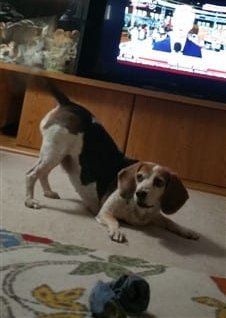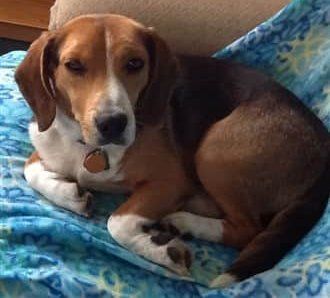When a Beagle Has Anxiety
Acting Fearful, Panicked, or Afraid
Overview
It's understandable that owners are taken by surprise if a Beagle has anxiety problems; after all, isn't this supposed to be an active, curious dog that not only carries himself in a poised manner but leaps into situations without being ruffled?
Well, the truth is that that is a description for the Beagle breed in general, and many Beagles are not quite self-assured and composed.
Beagles can be a bit jumpy, fearful of many things, and even have anxiety issues such as becoming afraid as soon as an owner leaves the room.
It should be noted that this section will discuss anxiety issues that happen when owners are home. If you are looking for help when your Beagle is home by himself, that is covered separately.
This section will cover:
- Common signs of anxiety
- Top reasons why a Beagle will be anxious
- Steps you can take to help
Percy, at 4 months old,
photo courtesy of Val
Signs that a Beagle has Anxiety
There are many different ways that a Beagle can act because it will be his overall composure during a wide range of events and situations that lets owners know that there is a problem.
However, some of the things that you may see include:
- Acting panicked at certain times. Commonly, it will be distance from his human which causes a Beagle to immediately show distress. This may occur seconds after an owner simply leaves the room for a moment.
- Acting jumpy. Normal everyday sounds that you wouldn't expect to phase a dog will startle him. This may include a door being closed, windows being opened, an oven timer going off, the phone ringing, etc.
- Overly clingy behavior. A Beagle may not be able to rest, sleep, or function in any self-confident way without his humans right by his side.
Clinical signs of anxiety include:
- Pacing
- Being overly alert
- Whining
- Excessive barking
- Tucking the tail down
- Trying to climb on owners
- Hiding (often in closets or other small areas)
- Shaking and trembling
-min-335x251-1920w.jpg)
First, It's Important to Rule Out Health Issues
Maybe your Beagle seems fine physically, and maybe you even just took him for a wellness check not that long ago... However, this does not mean that there is not a contributing health issue.
There are countless health conditions, illness, and diseases that have no outward clinical signs in the early stages. And although the last visit to the vet resulted in a big thumbs up, something may have developed from then to now.
It is VERY common for dogs to have a change in behavior when ill. This is due to feeling vulnerable.
It's really easy to brush this off and 'know' that your Beagle is physically fine. However, it is best to be 100% confident of that before you start any type of training or methods to fix this from a behavioral standpoint.
Senior Beagles
It is not uncommon for older, senior Beagles over the age of 9 or 10
to have some decreased hearing and/or vision. This alone can cause a dog to feel anxious and nervous.
There is also the possibility of CDD playing a role. Canine Cognitive Dysfunction is the canine equivalent of dementia in humans. This can cause changes in awareness, confusion, and deficits in learning, among other things.
For these reasons, new or worsening anxiety in seniors dogs always warrants a vet visit.
What Causes a Beagle to Feel Anxious
This is not a breed that is predisposed to anxiety, and we'll go forward under the assumption that health issues have been ruled out.
Of course, dogs can become afraid due to unpleasant or scary events; associations with things that have caused fear in the past can carry forward for quite some time. This would include past trauma or neglect suffered at an earlier age, including but not limited to Beagles formerly used for lab experiments.
However, in regard to an overall anxious personality, this is a different story. In some cases, a severe lack of exposure to triggers can be at the root of the problem; However, in many cases there may be no obvious connection to a Beagle's history.
How to Help a Beagle that is Anxious
It is important to note two things:
1)
It is not one element that will cure anxiety in a Beagle; it will be a combination of many smaller steps that all work together. So, you'll want to look this over and apply all that are applicable.
And 2)
In some cases, anxiety is so severe that it warrants professional intervention. This may include a processional trainer; but more often than not, it requires medications that help dogs with chemical imbalances. We will cover this more ahead.
Flo, at 12 weeks old, photo courtesy of Max
If this seems to be part of the problem, try closing the drapes and if needed, play tranquil music to help override disturbing sounds.
#2 Plan how you will react.
It is exceedingly common for owners to soothe, cuddle, or otherwise comfort their dog when he is acting anxious. After all, it is human instinct.
Dogs, and especially the Beagle due to his development as a hunter with strong behavioral traits of following his human's cues, are highly influenced by signals (verbal and non-verbal) that owners send out.
So, when you comfort your dog, this tells him that his behavior was warranted. Whether he got upset that you left the room or jumped when the doorbell rang, if you run over to comfort him, you will be sending a very strong message that he was correct to be worried.
And think about how many times your Beagle acted anxious and you inadvertently told him that it was a valid emotion. Twenty times, hundreds?
Dogs learn by repetition. So, there'll need to be quite a few sessions of reacting differently before your Beagle thinks about things in a different way. This said, don't let that discourage you; now is the time to start.
As mentioned, a Beagle anticipates receiving his human's signals; so, for this reason you also do not want to ignore how he is feeling.
Rather, you should:
1- Acknowledge
his anxiety in a VERY matter-of-fact voice and without using comfort works such as 'okay'. For example, in a carefree, everyday voice, say, "You were worried that I left? No big deal, silly guy."
2- Redirect.
Often, if you redirect your Beagle to an activity, the change in focus is enough for him to forget about what made him anxious in the first place.
This said, the entertainment value in that redirection must be strong enough.
What will do the trick?
Often it is a scent-based toy or a highly interactive toy. You will know your Beagle best as to which type will draw him into paying attention to something new.
Which ever you choose, you will want that toy(s) to be tucked away so that when you do redirect him to them, they will have the appeal of being something to discover and investigate.
Also, do not directly offer the toy; you do not want to give the idea that this is a reward. Rather, lead your Beagle to it.
#3 Gradual desensitization and socialization.
In many cases, controlled exposure to triggers can help a dog overcome his fears. This does not hold true for elements that would scare any dog and may not always work for deep phobias. However, it works well for many things.
This includes seeing certain visitors, hearing noises like the vacuum, or even having an owner leave a room.
For triggers including events, situations, noises, and the like, the idea is to offer regular sessions that start off very short. Anywhere from 10 seconds to 5 minutes, depending on what that trigger is. Carry yourself in a confident way, and speak in a matter-of-fact voice during this time. Do not take direct notice of whatever it is that normally spooks your Beagle.
Doing this daily is best. Every week, the duration is extended by another few minutes. As a Beagle is exposed to the element in this controlled way, he may be able to build up a tolerance. And your calm manner will help him learn that any fears are not fact-based.
End sessions when your Beagle is still doing well, so that things finish on a good note.
#4 For panicked behavior when you leave the room, things will be handled with a different approach.
If a Beagle does not have experience in being independent, it is entirely understandably that he would panic upon separation.
You will want to:
Arm your Beagle with tools
No dog is happy sitting in a room utterly bored with nothing to do than wait for his humans' return. And for dogs that panic like this, it's unrealistic to expect them to suddenly know how to deal with what is (from the Beagle's perspective) being abandoned.
You'll want to set things up in advance using some techniques to help dogs when home alone.
Which elements you use will depend on how long you step away.
For example, if it's winter and you are heading out to shovel the driveway, this is very much akin to leaving the house for work, so you'll want to implement all methods.
If, however, you just need to leave to take a shower, your Beagle may be helped by just a few of these.
Try some, and then if needed, add in some extras.
The idea behind this is to give your Beagle tools that he can rely on when he's faced with feelings of panic. He will learn to seek comfort from those elements, and not depend entirely upon you.
This will remove stress from your shoulders, and teach your Beagle self-reliance.
Setting up the environment that offers a foundation of success in being independent includes:
1- Soothing music.
Some dogs like to have a TV on, but these can be overly stimulating. And while you may be able to find a nice radio station, do be aware of commercials that can be too harsh for a dog that is trying to stay composed.
There are some great CD's, streaming, and MP3's that offer music specifically to help calm a dog. These can be great to have playing on a loop.
2- Treat release and interactive toys.
As mentioned earlier as part of the redirection method, toys that hold tempting treats but require work to release them, and toys that speak or let out funny noises are fantastic for keeping a dog distracted. If you save these for these particular times, and the toy is novel to the Beagle, all the better.
3- A companion toy.
Dogs that have playmates rarely feel panicked when owners step out of the room. In fact, you may wonder just how long it would take for them to notice.
But, what can you do if your Beagle is your sole pet? You'll be happy to know that there is a great solution that does not require bringing home another dog. The answer is to provide a companion toy.
The one that we recommend, the Original SmartPet Love Snuggle Puppy, mimics a living creature. These are very good sized, sturdy stuffed animals. There are two fantastic elements: 1)
These emit a rhythmic heartbeat
and 2) these, optionally, send out a comforting warmth. This is as close as you can get to giving your Beagle a real-life playmate.
Puppies love these due to feeling as if they are with a dam. Adults love these because it's like having a friend. And seniors tend to nurture these as if taking care of a younger counterpart.
Once you have prepped, and your Beagle has his supportive tools, it will be time to start some sessions.
You may have been living a bit on tiptoe, always staying close to your puppy or dog as to not set him off into a panic.
However, things will not improve unless you offer opportunities to learn.
With calming music playing, some great toys to stay busy, and maybe with a companion toy, start calming walking out of the room for short amounts of time.
Do not expect your Beagle to suddenly be perfectly okay.
However, as you do this each day, and you gradually increase the time, he will start to learn to seek out things that make him feel better.
Newman, photo courtesy of Barbara
The time that you step out depends on what has been happening. If you don't typically leave for work and are essentially always there, 5 or 10 minute sessions may be appropriate.
When you return, act very calm as if it were no big deal that you left. It is best if you do not immediately greet your Beagle when you come back; though this will be your first instinct. Rather, straighten out some magazines, take a sip of water, or otherwise busy yourself. After a minute or so, look over, say hello and continue on as if you never left.
#5 Confidence through commands.
One of the best ways for a dog to feel proud of himself and gain self-confidence is to learn new commands or tricks. And a confident dog is less apt to feel afraid when situations arise.
Just the element of learning - the session of trial and error, being rewarded for 'good tries', and finally 'getting it' offers a huge boost in self-esteem. Additionally, once a dog is able to follow a command, performing it brings about more bonuses, as he is gaining attention and and praise for his actions.
A dog of any age at all, from a new 8-week-old puppy to a 14 year old senior can learn a command or easy-level trick. So, this should be part of your plan to help your Beagle be less afraid of the world around him.
#6 Calming supplements.
Most OTC calming supplements for dogs are based on a holistic approach. Most come in chew form, though there are some powders. Ingredients may include chamomile, passion flower, ginger, thiamine mononitrate, L-Tryptophan, and/or melatonin.
These sorts of supplements are offered as a method to help dogs during stressful situations. These may be used for long car rides, airplane travel, to preemptively calm a dog when fireworks are going to be set off, and other situations.
Since these can make a dog feel drowsy, this is not something that can be effectively given for quick episodes of panicked behavior. You wouldn't want to give your Beagle a treat to calm him, only to have it take effect when he would have calmed down at any rate.
Additionally, while these work very well for some dogs, they do not work well for all dogs.
This all said, if this is something that you would like to try (in conjunction with the other listed methods), look for one that is made in the USA in a GMP compliant facility to ensure all-natural, safe ingredients.
Veterinary Intervention
It is possible for canines to suffer panic or anxiety attacks, just like humans can. While this can be due to past abuse and other terribly negative experiences, this is not true in all cases.
A dog can be raised in a wonderfully loving home, but still have these sorts of issues. In some cases, this is due to a chemical imbalance in the brain.
So, if the above guidelines do not bring about improvement, or if you think that your Beagle's anxiety is at a severe level, it will be time to seek professional help from the veterinarian.
Some of the more commonly prescribed medications to help dogs with anxiety include alprazolam, amitriptyline, buspirone, clomicalm, dexmedetomidine (Sileo), diazepam, fluoxetine (Reconcile), lorazepam, paroxetine, and sertraline.
The veterinarian will assess which triggers are causing your dog distress and prescribe the most appropriate treatment.
These can have some side effects, so this is something that you will want to discuss with the vet.
In some cases, just a short duration of 4 to 6 weeks is all that is needed. Other times, a dog may need to stay on a low dose.
Summary
Helping your Beagle with anxiety will take some patience and effort on your part. However, if you:
- Rule out health issues
- And issues related to senior dogs
And then use the techniques of:
- Reassessing the home environment
- Reacting appropriately with redirection
- Work on gradual desensitization
- Give your Beagle tools to help him handle things betters
- And teach self confidence via commands... You should see great improvement
If not, you may wish to try a calming supplement. And never hesitate to bring your Beagle to the veterinarian.

-min-240x335-1920w.jpg)

-min-246x335-1920w.jpg)
-min-218x335-1920w.jpg)

-min-226x335-1920w.jpg)

-min-330x335-1920w.jpg)

